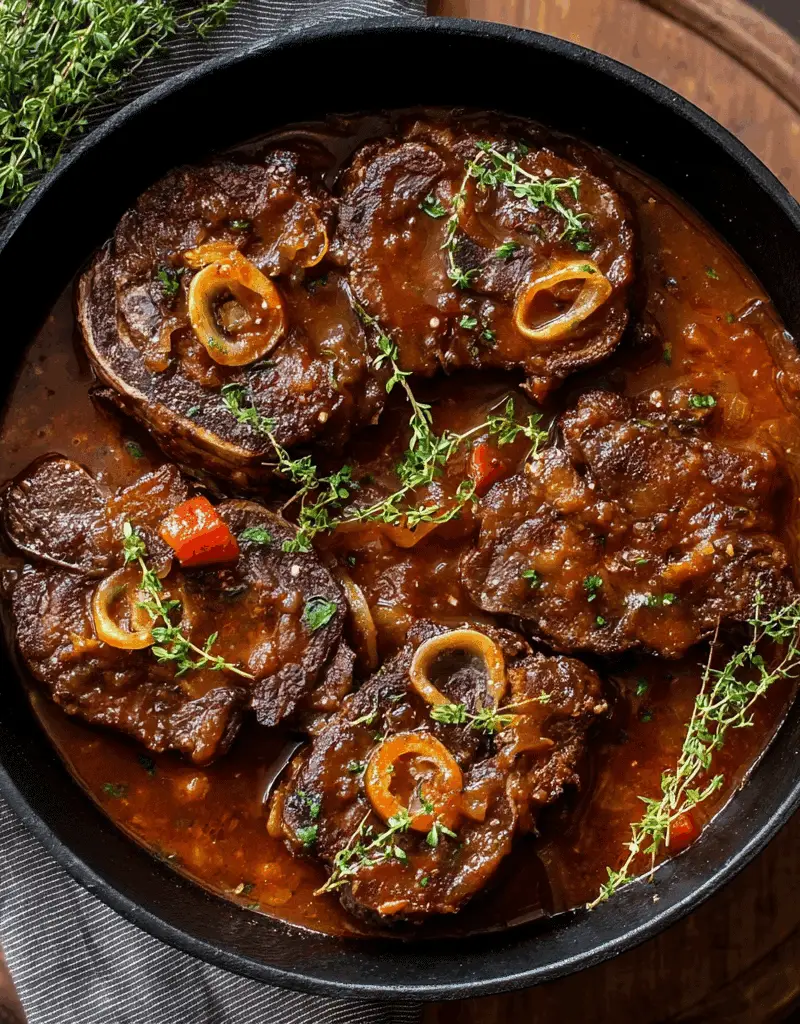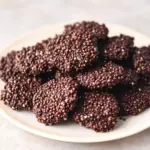Experience true comfort with this beef osso bucco—beef shanks slow-braised until they melt in your mouth, infused with the warmth of rosé, fragrant thyme, and rich beef stock. This dish is all about deep flavours and timeless tradition, perfect for gathering around the dinner table on a crisp afternoon.
Ideal for winter nights or relaxed Sunday dinners, it brings rustic elegance without fuss. Serve it with creamy mash, risotto or polenta to soak up that luscious sauce—you’ll be making this again and again.
Full Recipe
Ingredients:
-
1.5 kg beef osso bucco (shank cuts)
-
2 tbsp olive oil
-
¼ cup plain flour
-
1 large brown onion, diced
-
2 carrots, sliced
-
2 stalks celery, sliced
-
4 cloves garlic, crushed
-
1 cup rosé wine
-
1 can (400 g) diced tomatoes
-
2 cups beef stock
-
6 sprigs thyme
-
50 g butter
-
Salt & black pepper to taste
Directions:
-
Lightly dredge beef shanks in flour seasoned with salt & pepper.
-
Heat oil in a heavy casserole, brown shanks on all sides, remove and set aside.
-
Sauté onion, carrot, celery, garlic until soft (~5 min).
-
Deglaze with rosé, scraping brown bits, then add tomatoes, stock, thyme.
-
Return shanks, cover and simmer gently on low heat or bake at 140 °C (280 °F) for ~3–4 hrs until meat is falling off the bone.
-
Stir in butter before serving for richness.
Prep Time: 20 min | Cooking Time: 3 hrs | Total Time: 3 hrs 20 min | Kcal: ~650 kcal per serving | Servings: 4
A Culinary Classic: Beef Osso Bucco
Beef Osso Bucco is a traditional Italian dish with roots in the Lombardy region, particularly Milan. The name “osso bucco” translates to “bone with a hole,” referencing the marrow-filled bone at the center of the beef shank. This dish celebrates simplicity and patience, turning a humble cut of meat into a melt-in-your-mouth masterpiece through slow braising. Traditionally made with veal, the beef version has gained popularity for its deeper, more robust flavor and accessibility.
This comforting and hearty dish is a shining example of how rustic cooking techniques, paired with quality ingredients, can yield results that rival any fine dining experience. Osso Bucco isn’t just food—it’s an experience steeped in heritage, warmth, and connection.
Why Use Beef Instead of Veal?
While veal osso bucco is the classic approach, beef has become the preferred protein for many home cooks and chefs due to its affordability, availability, and richer taste. Beef shanks, when properly cooked, develop an intense depth of flavor and a luxurious texture that makes this dish immensely satisfying. The connective tissues in beef break down beautifully during the slow cooking process, giving the sauce a natural silkiness without needing thickeners or extra fat.
Moreover, beef osso bucco lends itself well to different flavor profiles. It handles bold seasonings and wines, like rosé or red wine, much better than veal, making it adaptable and forgiving for creative cooks.
The Importance of the Braising Method
At the heart of Osso Bucco lies the braising method—a low and slow cooking technique that transforms tough cuts into tender, flavorful bites. First, the beef is seared to build a rich caramelized crust that forms the base for the sauce. Then it’s simmered slowly with aromatic vegetables, herbs, and liquid (usually a combination of wine and stock), allowing flavors to meld and intensify over hours.
This technique isn’t just about tenderness. It’s also about layering flavors and creating a cohesive, complex dish. The long cooking time allows the meat to absorb every nuance of the herbs, vegetables, and wine, resulting in a sauce that’s thick, savory, and perfect for spooning over polenta or mashed potatoes.
Flavor Foundations: The Role of Aromatics
The flavor profile of a good osso bucco relies heavily on aromatic vegetables like onion, celery, garlic, and carrot. These vegetables form the base of the “soffritto,” a classic Italian cooking foundation. When slowly sautéed, these ingredients release their natural sugars and provide a delicate sweetness that balances the acidity of the wine and tomatoes.
Fresh thyme, rosemary, and bay leaves add herbal depth, while garlic lends a warming kick. The use of rosé wine in this version introduces a light, floral character that elevates the dish without overpowering the beef’s natural richness.
Cooking Wine: Rosé’s Role in This Dish
While red and white wines are often used in braised dishes, rosé strikes a perfect balance. It has the acidity needed to tenderize the meat and the fruit-forward notes that complement the tomatoes and herbs in the sauce. Rosé also brings a subtle brightness to the dish, helping lift its otherwise deeply savory profile. This makes the recipe less heavy than one made with red wine, and especially ideal for year-round enjoyment—even in warmer months.
If you don’t have rosé, a dry white or light red wine can be used as alternatives, but rosé truly offers a unique dimension that sets this version apart.
The Finishing Touch: Butter for Body and Shine
One small but significant addition at the end of the cooking process is butter. Stirring in a knob of butter before serving enriches the sauce, adding a glossy finish and silky mouthfeel. This French-inspired technique balances the robust flavors and brings harmony to the dish.
It’s a small step that makes a big difference and highlights the importance of mindful finishing touches in home cooking. It also helps balance the acidity from the tomatoes and wine, creating a round, well-seasoned dish that feels luxurious without being overly fatty.
Pairing Suggestions: Sides and Wines
This dish pairs beautifully with creamy polenta, mashed potatoes, or a soft risotto. The goal is to serve it with something that will soak up that rich, wine-infused sauce. For a low-carb option, roasted cauliflower mash or a parsnip purée makes a fine substitute.
As for wine pairings, you can’t go wrong with a glass of the same rosé used in the recipe. However, fuller-bodied reds like Barolo, Chianti, or Cabernet Sauvignon also complement the beef’s richness and the herbaceous sauce. These wines enhance the dish’s depth without overwhelming its nuanced flavors.
A Dish That Improves with Time
Like many braised dishes, beef osso bucco tastes even better the next day. As it sits in the fridge, the flavors continue to develop and marry, giving you an even more satisfying meal upon reheating. This makes it an ideal dish to prepare ahead of time for dinner parties or busy weeks.
It also freezes well, making it a great option for batch cooking or meal prepping. Simply cool it completely, portion it out, and freeze in airtight containers. It will keep well for up to 3 months.
Nutritional and Dietary Considerations
Beef osso bucco is naturally gluten-free (as long as you use gluten-free flour for dredging), and can be made dairy-free by omitting the butter finish. It’s high in protein and iron, especially due to the marrow in the bone, which also contains collagen and other nutrients.
Though it’s a richer dish, it offers balance thanks to the use of vegetables and a lean cut of beef. For those on a keto or low-carb diet, it pairs well with cauliflower mash or grilled greens.
Cultural Significance and Global Variations
In Italy, osso bucco is traditionally served with “gremolata”—a mixture of parsley, lemon zest, and garlic—that cuts through the richness of the dish. While this version may not include gremolata, it can be added as a garnish to introduce a fresh, zesty contrast to the slow-cooked flavors.
Across the globe, variations of osso bucco have emerged using different meats like pork or lamb and a variety of braising liquids including beer or even sake. Each region adds its own flair, but the technique and comforting nature of the dish remain universal.
The Ideal Occasion for Beef Osso Bucco
Whether you’re preparing a cozy family dinner or planning an impressive meal for guests, beef osso bucco suits nearly any occasion. It’s refined enough for special events, yet rustic enough for everyday meals. The long cook time means it requires some planning, but most of it is hands-off, making it ideal for weekends when you want to let something simmer on the stove while you unwind.
It also presents beautifully when served directly in the pot, adding to its rustic charm and making it a centerpiece-worthy dish for your dining table.
Conclusion: A Dish Worth the Time
Beef Osso Bucco is a slow-cooked marvel that proves great food doesn’t have to be complicated—just patient. By using accessible ingredients and a traditional braising technique, you can create a luxurious meal that delivers on both flavor and comfort. From its origins in Milanese kitchens to your modern-day dinner table, osso bucco is a celebration of time-honored cooking and soulful eating.
Serve it with love, enjoy the leftovers, and savor every bite—it’s the kind of meal that stays in your memory long after the plates are cleared.








